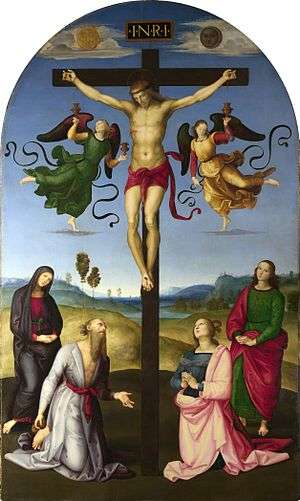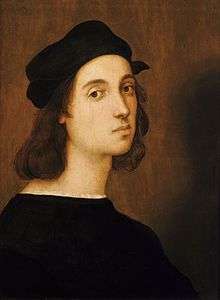Mond Crucifixion
 | |
| Artist | Raphael |
|---|---|
| Year | 1502–3 |
| Type | Oil on poplar |
| Dimensions | 283.3 cm × 167.3 cm (111.5 in × 65.9 in) |
| Location | National Gallery, London |
The painting
The Mond Crucifixion (or Crocifissione Gavari; both names are after former owners) is a painting by the Italian renaissance artist Raphael.
An early work influenced by Perugino, it was originally an altarpiece in the church of San Domenico, Città di Castello, near Raphael's hometown of Urbino. The painting shows Jesus on the cross, who is looking peaceful even though he is dying. There are two angels catching his blood in chalices. On Jesus' left kneels Mary Magdalene, with John the Evangelist standing behind her. On his right Mary stands, and St. Jerome, to whom the altar was dedicated, is kneeling. At the foot of the cross is the inscription RAPHAEL/ VRBIN / AS /.P.[INXIT] ("Raphael of Urbino painted this") in silver letters.
The painting was bequeathed to the National Gallery by Ludwig Mond.
The sun and moon at the top are present despite the Council of Constantinople prohibition of such symbology for its reference to other religions.
Painting materials
The painting was analyzed in the National Gallery London[1] and the typical pigments of the Renaissance period were identified. He painted the Crucifixion among other pigments with natural ultramarine, lead-tin-yellow, verdigris, vermilion and ochres[2]
References
- ↑ Roy, A., Spring, M., Plazzotta, C. ‘Raphael’s Early Work in the National Gallery: Paintings before Rome‘. National Gallery Technical Bulletin Vol 25, pp 4–35.
- ↑ Raphael, The Mond Crucifixion, ColourLex
